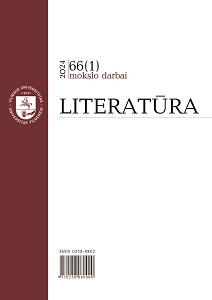Kančia pagal AntanąVienuolį, arba dar kartą apie gamtos figūras ir žmogiškas reikšmes apsakyme „Paskenduolė“
The Passion according to Antanas Vienuolis, or Once again about Figures of Nature and Human Meanings in the Short Story “The Drowned Girl”
Author(s): Loreta MačianskaitėSubject(s): Semiotics / Semiology, Studies of Literature, Semantics, Lithuanian Literature, Sociology of Literature
Published by: Vilniaus Universiteto Leidykla
Keywords: Semiotics; Lithuanian literature; parable; pluri-isotopic text; semantic universe; myth; Algirdas Julien Greimas;
Summary/Abstract: This research focuses on the most studied work of the Lithuanian literature – the short story “The Drowned Girl” by Antanas Vienuolis (lt. „Paskenduolė“, written in 1909, published in 1913). It responds to the analysis of Guy de Maupassantʼs “Two Friends” conducted by Algirdas Julien Greimas and its disturbing assertion that the analyzed story should be read as a symbolist rather than a realist text. The study reveals the polemic structure of sociolectal and idiolectal representations of values and reconstructs two figurative universes. The short story fits the definition of a pluri-isotopic discourse and can be considered both a para-Christian and an anti-Christian myth. The analyzed text is related to the implicit narrative of the prayers on the Rosary and the Stations of the Cross, as well as the cycle of summer holidays, opening access to an anagogical sense. The suggestiveness of this work can be understood through its communicative strategy, which evokes emotional engagement similar to that found in religious art. One of the most important aspects of this short story is the audience’s orientation toward independent perception, which is typical of parables. The study concludes that “The Drowned Girl” is the first modern mythical discourse in the Lithuanian literature.
Journal: Literatūra
- Issue Year: 66/2024
- Issue No: 1
- Page Range: 98-116
- Page Count: 19
- Language: Lithuanian

